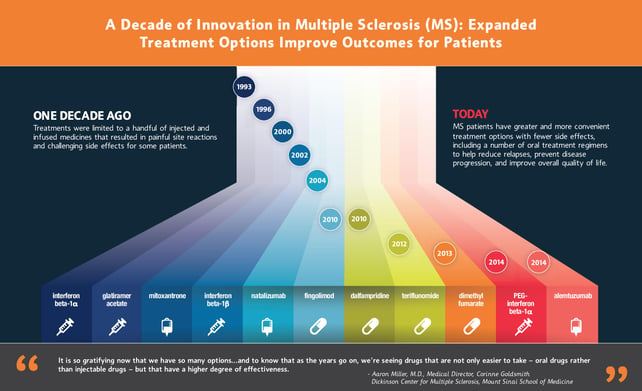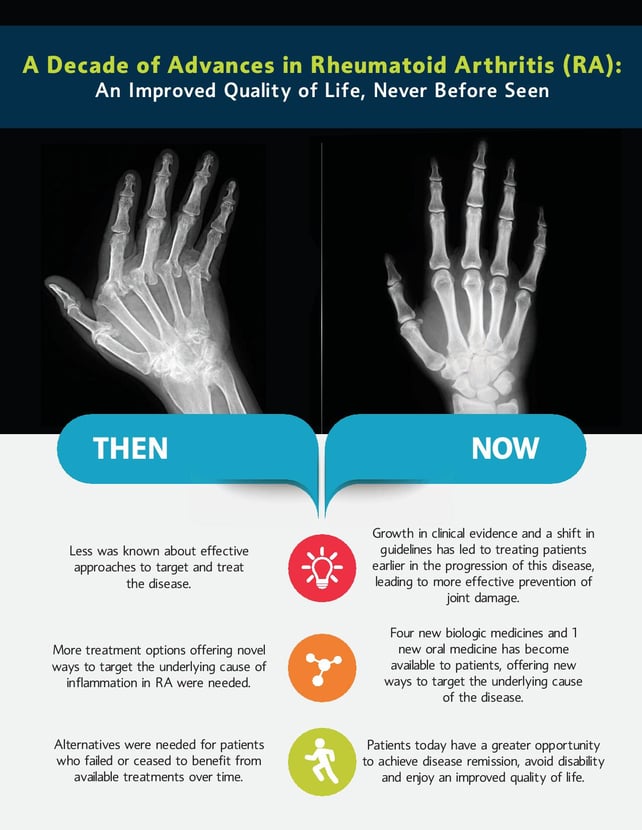
New report celebrates a decade of progress in chronic diseases
Print
01 March 2016
Holly Campbell / PhRMA
In the last 10 years, incredible progress has been made by the biopharmaceutical industry in the treatment of chronic diseases. With about half of all Americans, or 117 million people, living with one or more chronic health conditions, this innovation is more critical than ever. Patients with chronic diseases are frequent users of medical care, accounting for 81 percent of hospital admissions and 76 percent of physician visits. Treating these diseases is hugely expensive with 86 cents of every health care dollar spent in the United States going toward treating chronic illness, and the scope and severity of the problem is only expected to increase. If left unchecked, chronic diseases could bankrupt the U.S. health care system.
The facts are alarming, but a new PhRMA report, “A Decade of Innovation in Chronic Diseases,” highlights several chronic health conditions where significant advances over the past decade have helped patients avoid serious disease complications and hospitalizations, and improved quality of life. The report examines remarkable innovations in treating high cholesterol, diabetes, multiple sclerosis, rheumatoid arthritis, HIV/AIDS and hepatitis C. In many chronic diseases, individual patients respond to various medications differently, underscoring the importance of therapeutic advances that offer patients a broad range of options.
Here are highlights from the report:
High cholesterol
Then: The introduction of statin therapy in the late 1980s had a dramatic effect on the treatment of high cholesterol. However, patients with cholesterol two to five times higher than normal were left with limited options.
Now: Patients unable to effectively control their cholesterol levels with statin therapy have four new, innovative treatment options from three entirely new classes of cholesterol-lowering medicine, including PCSK9 inhibitors. With 40 medicines in development to treat patients with high cholesterol, patients have more hope than ever before.
Diabetes
Then: Patients had just several insulin options available for the treatment of diabetes, including oral, pen and pump treatment options. But pill burden remained high for many patients and more convenient and less complex options were needed for those who continued to struggle to gain control of the disease.
Now: In the past 10 years, more than 20 medicines have been developed to treat the complex needs of patients with type 1 and type 2 diabetes. Among these medicines are two entirely new classes of oral therapies, 10 oral combination therapies offering to reduce pill burden and two ultra-long-acting insulins, greatly expanding treatment options for patients. The progress continues with 180 medicines in development today for diabetes and its related conditions.
Multiple sclerosis
Then: Patients suffering with multiple sclerosis (MS) a decade ago had several treatment options that are still in use today. While many were effective at treating the disease, the medicines were commonly injected or infused and often resulted in painful site reactions and challenging side effects.
Now: MS patients can now choose from a variety of medicines and administration options. For the first time, three oral medicines are available, helping patients more effectively and comfortably manage their condition. Right now, 40 new medicines are in development to treat MS, including some offering to provide first-time treatments for patients with the progressive form of the disease.

Rheumatoid arthritis
Then: Ten years ago, patients were just beginning to use biologic medicines to target the underlying source of inflammation and joint damage involved in rheumatoid arthritis, rather than just treating the symptoms of the disease. However, biologic medicines were only prescribed for the most advanced cases. There were also few options for patients who did not respond to the available treatments at the time.
Now: Many new classes of treatment for rheumatoid arthritis have been developed, providing patients with new ways to target the underlying cause of the disease – including a new first-in-class oral medicine offering greater convenience for patients. Clinical research has shown to administer treatment earlier in the progression of the disease, resulting in better disease management and improved outcomes.

HIV/AIDS
Then: Four classes of antiretroviral treatment were available to HIV-positive patients a decade ago. However, as treatment with multiple antiviral therapies was the cornerstone HIV treatment, pill burden and adherence remained a challenge. There were also few treatment options to help patients manage the side effects of treatment.
Now: In the past 10 years, 15 new medicines have been approved – including 3 new entirely classes of therapy, as well as treatments which reduce pill burden by combining multiple antiretroviral treatments into a once-daily pill. New treatments alleviating common side effects of the disease have also become available allowing for better disease management. Such advances have contributed to the 10-year increase in average life expectancy we’ve seen in the last decade alone.
Hepatitis C
Then: The only option available to hepatitis C patients a decade ago was an injected therapy administered over a course of 24 - 48 weeks, which caused debilitating side effects and only cured about half of patients.
Now: Today, new and highly effective oral treatment options offer cure rates over 90 percent in as little as eight weeks and with minimal side effects.
As the burden of chronic disease grows in the coming years, these treatment advances, and those to come, will continue to play a central role in alleviating substantial burden for patients and caregivers, as well as the health care system. We owe it to America’s patients to continue this progress, underscoring the need to maintain an ecosystem that fosters the development of tomorrow’s treatments and cures.
Read the report here: http://phrma.org/decade-of-innovation
All Portfolio
MEDIA CENTER
-
The RMI group has completed sertain projects
The RMI Group has exited from the capital of portfolio companies:
Marinus Pharmaceuticals, Inc.,
Syndax Pharmaceuticals, Inc.,
Atea Pharmaceuticals, Inc.

